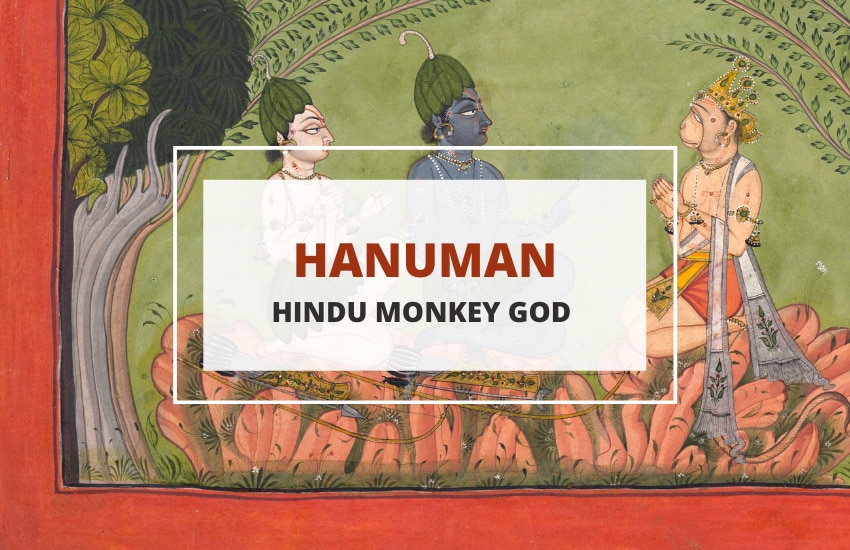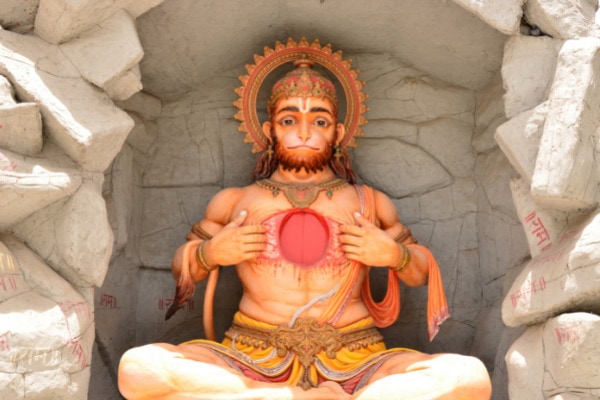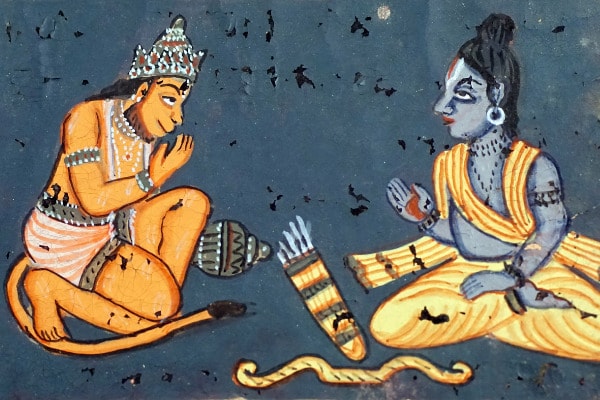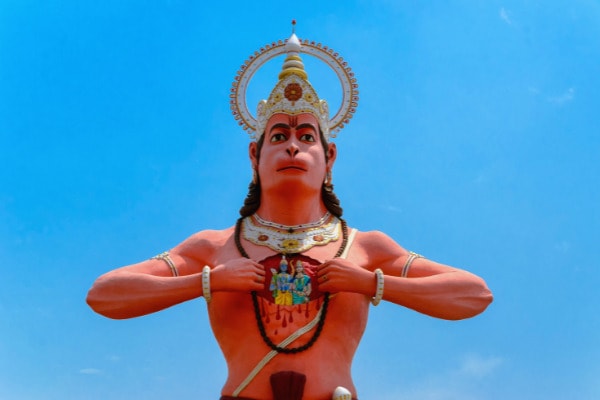
Table of Contents
Several eastern mythologies have monkey gods but the Hindu Hanuman is arguably the oldest of all of them. A very powerful and highly revered deity, Hanuman plays a key role in the famous Sanskrit poem Ramayana and is worshipped by Hindus to this day. But what exactly is so special about Hanuman that makes a monkey worthy of worship?
Who is Hanuman?

Hanuman is a powerful monkey god and one of the Vanaras – an intelligent monkey warrior race in Hinduism. His name translates as “disfigured jaw” in Sanskrit, referring to an interaction Hanuman had with the god Indra in his youth.
Son of the Wind God
There are several myths regarding Hanuman’s birth but the most famous one includes a devout Vanara monkey named Anjana. She prayed to Shiva for a son with such fervor that the god eventually sent his blessings through the wind god Vayu and who flew Shiva’s divine power into Anjana’s womb. That’s how Anjana became pregnant with Hanuman.
Curiously, this doesn’t make the monkey god a son of Shiva but rather a son of the wind god Vayu. Still, he is also often referred to as an avatar of Shiva as well. Not all Hindu schools accept this concept but it’s still a fact that both Shiva and Hanuman are perfected yogi and possess the eight siddhis or mystic perfections. These include:
- Laghima – the ability to become as light as a feather
- Prakamya – the ability to achieve everything you set your mind to
- Vasitva – the ability to control nature’s elements
- Kamavasayita – the ability to shapeshift into anything
- Mahima – the ability to grow in size
- Anima – the ability to become incredibly small
- Isitva – the ability to destroy and create everything with a thought
- Prapti – the ability to instantly travel anywhere in the world
These are all abilities human yogis believe they can achieve with enough meditation, yoga, and enlightenment but Hanuman was born with them thanks to his relation to Shiva and Vayu.
A Disfigured Jaw
According to the story, young Hanuman was blessed with various magical powers such as the ability to grow in size, to jump great distances, to have amazing strength, as well as the ability to fly. So, one day, Hanuman look at the sun in the skies and mistook it for a fruit. Naturally, the monkey’s next instinct was to take flight toward the sun and try to reach it and pluck it from the skies.
Upon seeing that, the Hindu king of heaven Indra felt threatened by Hanuman’s feat and struck him with a thunderbolt, felling him unconscious to the ground. The thunderbolt had struck Hanuman directly on the jaw, disfiguring it and giving the monkey god his name (hanu meaning “jaw” and man meaning “prominent”).
Thinking his son was dead, Vayu became enraged and sucked the air out of the universe. Suddenly desperate, Indra and the other heavenly gods reached out to Brahma, the engineer of the universe for help. Brahma looked into Hanuman’s future and saw the amazing feats he would one day accomplish. So, the universe’s engineer revived Hanuman and all the other gods started blessing the monkey with even more powers and abilities. This appeased Vayu and he returned the air necessary for life to exist.
Stripped of His Powers
Getting smacked down by Indra for reaching towards the sun wasn’t the last time Hanuman got punished for his mischievousness. As a young Vanara, he was so lively and restless that he constantly annoyed the sages and priests at the local temple where he grew up. Everyone got so fed up with Hanuman’s antics that they eventually gathered together and cursed him to forget his powers.
This essentially stripped Hanuman of his god-given abilities and turned him into a normal Vanara monkey, the same as all the others. The curse stipulated that Hanuman would only ever regain his abilities if someone reminded him that he had them. Hanuman spent many years in this “underpowered” form until the time when the Ramayana poem took place.
Avatar of Devotion and Dedication

It’s the story in the famous Ramayana poem by Sage Valmiki that makes Hanuman so integral to Hinduism and why he’s worshipped as an avatar of devotion and dedication. In the poem, the exiled prince Rama (himself an avatar of Vishnu) journeys across the ocean to rescue his wife Sita from the evil king and demigod Ravana (presumably residing in modern-day Sri Lanka).
Rama didn’t travel alone. He was accompanied by his brother Lakshman and by many Vanara monkey warriors including (the still powerless) Hanuman. Even without his heavenly abilities, however, Hanuman impressed prince Rama with his amazing accomplishments in the many battles they fought on their way to Ravana and Sita.
Little by little, the friendship between Rama and Hanuman grew and developed as the prince watched the monkey’s courage, wisdom, and strength. Hanuman expressed such devotion to prince Rama that he forever became known as an avatar of loyalty and dedication. That’s why you can often see the Vanara monkey portrayed kneeling in front of Rama, Lakshman, and Sita. In some depictions, he’s even pulling apart his chest to show an image of Rama and Sita where his heart should be.
It was during their adventures on the quest for Sita that Hanuman’s true powers were eventually reminded to him. As prince Rama and the Vanaras were wondering how they could cross the vast ocean to Sita, the bear king Jambavan revealed that he knew of Hanuman’s divine origin.
Jambavan told Hanuman’s whole story in front of Rama, the Vanaras, and Hanuman himself and thus he ended the monkey god’s curse. Divine once again Hanuman suddenly grew in size by 50 times, squatted down, and sprang across the ocean with a single bound. In doing so, Hanuman almost singlehandedly helped Rama save Sita from Ravana.
Revered to This Day

Once Sita was rescued, it became time for Rama and the Vanaras to part ways. However, Hanuman’s bond with the prince had grown so strong that the monkey god didn’t want to be parted with him. Fortunately, as both were connected to the Divine, one as an avatar of Vishnu, and the other as a son of Vayu, they were never truly apart even when they parted ways.
That’s why you can always see statues and images of Hanuman in Rama’s temples and shrines. That’s because Hanuman exists metaphysically wherever Rama is worshipped and glorified. Rama’s worshippers would also pray to both him and Hanuman so that the two would be together even in their prayers.
Symbolism of Hanuman
Hanuman’s story is bizarre in that many of its details are seemingly unrelated. After all, monkeys aren’t exactly known as loyal and devoted animals to humans.
Hanuman’s early years also portray him as reckless and mischievous – a vastly different person than the personification of dedication and devotion he later becomes.
The idea behind this transformation is that it’s the trials and tribulations he goes through without his powers that humble him and turn him into the hero he later becomes.
Hanuman is also a symbol of discipline, selflessness, devotion, and loyalty – apparent in his respect and love towards Rama. A popular depiction of Hanuman shows him tearing open his chest, revealing mini images of Rama and Sita in his heart. This is a reminder to devotees to keep these gods close to their hearts as well and to be perseverant in their beliefs.
Importance of Hanuman in Modern Culture
Hanuman may be one of the oldest characters in Hinduism but he’s popular to this day. There are countless books, plays, and even movies in recent decades dedicated to the monkey god. He has also inspired monkey deities in other Asian religions such as the famous Sun Wunkong in Chinese mythology.
Some of the famous movies and books featuring the character include the 1976 Bollywood biopic Bajrangbali with the wrestler Dara Singh in the main role. There was also a 2005 animated movie called Hanuman and whole series of subsequent films running from 2006 to 2012.
There was also a Hanuman reference in the 2018 MCU hit Black Panther, although the reference was removed from the film in screenings in India as not to offend the Hindu people there.
In Conclusion
Hinduism has some 1.35 billion followers around the world today and for many of them the monkey god Hanuman is not just a mythological figure but an actual deity to be worshipped. This makes the monkey god’s story all the more fascinating – from his immaculate conception to the loss of his powers to his amazing feats in service of Rama. He’s also a deity that has spawned many “copycat” gods across other religions which makes his continuous worship millennia later all the more impressive.








